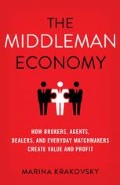Abstract
Early in World War II, the Germans captured a young British soldier named R. A. Radford and sent him to an Italian Oflag, a prisoner of war camp for officers. The camp, like other Oflags, was run in accord with the Geneva Convention, which meant, among other things, that the prisoners didn’t have to work to earn their keep. The captors took care of the prisoners’ basic needs, and in addition the captives received occasional parcels from the Red Cross—packages consisting of canned beef and salmon, milk and butter and cheese, even small luxuries like cigarettes and chocolate. A few lucky prisoners received private care packages as well.
THE ROLE: The Bridge promotes trade by reducing physical, social, or temporal distance. The most effective ones spot opportunities between disconnected individuals and groups. Bridges also understand that they must have something to offer each side from the get-go.
Access this chapter
Tax calculation will be finalised at checkout
Purchases are for personal use only
Preview
Unable to display preview. Download preview PDF.
Notes
R. A. Radford, “The Economic Organisation of a P.O.W. Camp,” Económica 12, no. 14 (November 1945): 189–201
Tiziana Casciaro, Francesca Gino, and Maryam Kouchaki, “TheContaminating Effects of Building Instrumental Ties: How Networking Can Make Us Feel Dirty,” Administrative Science Quarterly 59, no. 4(2014): 705–35.
Kent Grayson, “Friendship Versus Business in Marketing Relationships,” Journal of Marketing 71 (October 2007): 121–39.
This is the principle of “indirect reciprocity”: I help you and somebody else helps me. See Martin A. Nowak and Karl Sigmund, “Evolution of Indirect Reciprocity,” Nature 437 (2005): 1291–98.
For example, see Nathan Eagle, Sandy Pentland, and David Lazer, “Inferring Friendship Network Structure by Using Mobile Phone Data,” Proceedings of the National Academy of Sciences 106, no. 36 (2009): 15274–78.
See, for example, Anatol Rapoport and William J. Horvath, “A Study of a Large Sociogram,” Behavioral Science 6, no. 4 (October 1961): 279–91
Carlo Morselli, Inside Criminal Networks (New York: Springer, 2009).
Mark Granovetter, Getting A Job: A Study of Contacts and Careers (Cambridge, MA: Harvard University Press, 1974) and “The Strength of Weak Ties,” American Journal of Sociology 78, no. 6 (May 1973): 1360–1380.
Ronald Burt, Structural Holes: The Social Structure of Competition (Harvard University Press, 1992).
Ron Burt, “Structural Holes and Good Ideas,” American Journal of Sociology 110, no. 2 (September 2004): 349–399.
Ronald Burt, Structural Holes: The Social Structure of Competition (Harvard University Press, 1992), 28.
This research is described in Ron Burt, Neighbor Networks (New York: Oxford University Press, 2010).
Buyers of classified ads saved $5 billion between 2000 and 2007 as a result of Craigslist entering the market. See Robert Seamans and Feng Zhu, “Responses to Entry in Multi-Sided Markets: The Impact of Craigslist on Local Newspapers,” Management Science 60, no. 2 (February 2014): 476–493.
He is selling it online as an e-book. See Lajuan Stoxstill-Diggs, The Craigslist Hustle (LSD Publishing, 2009).
Anil K. Kashyap, Raghuram Rajan, and Jeremy C. Stein, “Banks as Liquidity Providers: An Explanation for the Coexistence of Lending and Deposit Taking,” The Journal of Finance 57, no. 1 (February 2002): 33–73.
Interview with Marc Rysman, January 31, 2014. Rysman’s contribution to the literature is Marc Rysman, “The Economics of Two-Sided Markets,” Journal of Economic Perspectives 23, no. 3 (2009). Another survey paper is Jean-Charles Rochet and Jean Tirole, “Two-sided Markets: A Progress Report,” RAND Journal of Economics 37, no. 3 (September 2006): 646–67.
The classic paper describing increasing returns to scale is W. Brian Arthur, “Competing Technologies, Increasing Returns, and Lock-In By Historical Events,” The Economic Journal 99, no. 394 (March 1989). A less academic account of these ideas by the same author is W. Brian Arthur, “Increasing Returns and the New World of Business,” Harvard Business Review 74, no. 4 (July/August 1996): 100–109.
Chris Anderson, Free: The Future of a Radical Price (New York: Hyperion, 2009), 3.
Scholars talk about multi-homing versus single-homing: under multi-homing, a user can belong to multiple networks at once; under single-homing, a user must belong to one network exclusively. See Mark Armstrong, “Competition in Two-sided Markets.” RAND Journal of Economics 37, no. 3 (September 2006): 668–91.
Adam Grant, Give and Take: A Revolutionary Approach to Success (New York: Viking, 2013), 43–46.
According to Relational Models Theory, this assumes that buyers (parents looking for sitters) agree that SitterCity is a market and therefore seeking profits is appropriate. See Alan Fiske, “The Four Elementary Forms of Sociality: Framework for a Unified Theory of Social Relations,” Psychological Review 99, no. 4 (1992): 689–723.
Thiers is using the term “tipping point” in Malcolm Gladwell’s sense—the moment at which something suddenly starts to spread like wildfire. Scholars of two-sided networks also talk about tipping (although not tipping points), but they mean something rather different: “the tendency of one system to pull away from its rivals in popularity once it has gained an initial edge,” according to a seminal paper on network effects. See Michael L. Katz and Carl Shapiro, “Systems Competition and Network Effects,” Journal of Economic Perspectives 8, no. 2 (Spring 1994): 106. This kind of tipping doesn’t always occur. For example, when users can simultaneously be on two or more platforms (multi-homing), a single platform need not prevail—so while SitterCity may have reached a tipping point, the matchmaking between parents and babysitters hasn’t tipped toward any one platform.
Panle Jia Barwick and Parag A. Pathak, “The Costs of Free Entry: An Empirical Study of Real Estate Agents in Greater Boston,” Ran of Journal of Economics 46, no. 1 (Spring 2015): 103–45.
Chang-Tai Hsieh and Enrico Moretti, “Can Free Entry be Inefficient? Fixed Commissions and Social Waste in the Real Estate Industry,” Journal of Political Economy 111, no. 5 (2003): 1076–122.
Copyright information
© 2015 Marina Krakovsky
About this chapter
Cite this chapter
Krakovsky, M. (2015). The Bridge. In: The Middleman Economy. Palgrave Macmillan, New York. https://doi.org/10.1007/978-1-137-53020-2_2
Download citation
DOI: https://doi.org/10.1007/978-1-137-53020-2_2
Publisher Name: Palgrave Macmillan, New York
Print ISBN: 978-1-349-57655-5
Online ISBN: 978-1-137-53020-2
eBook Packages: Palgrave Social Sciences CollectionSocial Sciences (R0)

